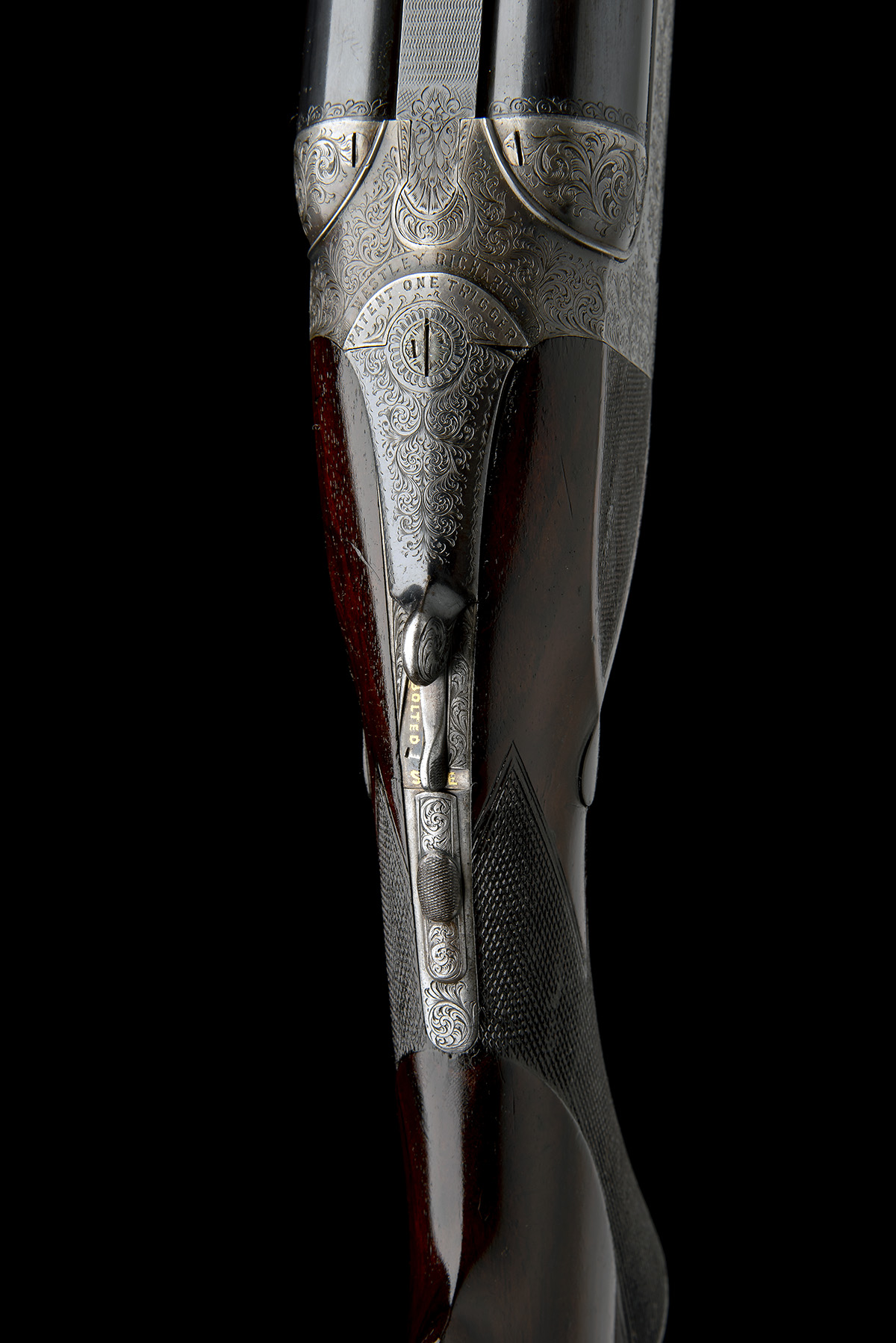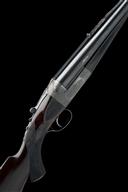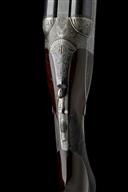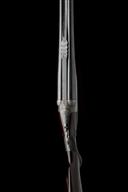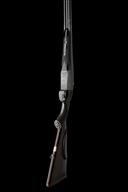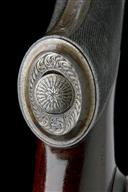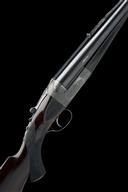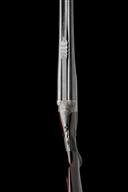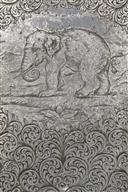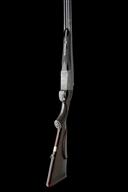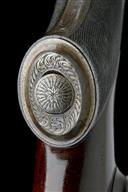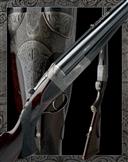Product Details
WESTLEY RICHARDS
A FINE .425 MAGNUM EXPRESS SINGLE-TRIGGER 1897 PATENT DETACHABLE-LOCK EJECTOR DOUBLE RIFLE, serial no. 17808,
for 1921, 26in. nitro barrels (proofed Cordite 65, 410 Max) with finely file cut sight rib and bold acanthus scrollwork to the forward ramp section, open sights with four folding leaf sights, white metal inlaid sight lines and marked for 100, 200, 300, 400 and 500 Yds, block-mounted bead fore-sight with flip-up moonsight and hinged folding protector hood, sunken rib engraved 'WESTLEY RICHARDS 23 CONDUIT ST. LONDON GUN MAKERS BY APPOINTMENT TO HIS MAJESTY GEORGE V. REX ET IMP.' and with carved shell design and acanthus scroll engraving towards the muzzle, the under rib with similar acanthus and shell embellishments at the muzzle, the tubes engraved 'W.R. .425 MAGNUM EXPRESS', '65 GRS CORDITE 410 GRS. BULLET', treble-grip action with striker discs, Westley Richards patent toplever engraved 'WESTLEY RICHARDS PATENT ONE TRIGGER', bolted automatic safety with gold-inlaid 'BOLTED' and 'SAFE' details, J. Deeley and L.B. Taylor patent hand-detachable locks, patent no. 17731 of 28th July 1897 with improved 'lighter pull-off' modification, patent no. 10567 of 7th May 1907, use number 2727, locks with engine turned finish, L.B. Taylor patent hinged floorplate, patent no. 23088 of 30th October 1908, L.B. Taylor modified 'two pull' selective single trigger, patent no. 26659 of November 17th 1909, use number 470, triggerplate mounted selector switch with gold-inlaid 'L' and 'R' detail, profusely engraved with bold acanthus scrollwork, the floorplate with a single vignette of an Indian elephant, the triggerguard with a prowling tiger, retaining traces of original colour-hardening, 14 3/4in. well-figured pistolgrip stock with cheekpiece, engraved steel pistolgrip-cap (with trap), sling swivels and including 1/2in. wooden extension and 3/4in. rubber recoil pad, fore-end with Deeley & Edge patent release catch and horn finial, weight 11lb. 13oz., in its brass-cornered leather case, the lid outer initialled 'C.N.'
Provenance: The vendor has kindly informed us this was formerly the property of his Grandfather, Claude Nicholson.
Brigadier Claude Nicholson is known the world over for his heroic defence of Calais in May 1940. After the invasion of the Low Countries and France by the Germans, the British Army was rapidly pushed back and forced to evacuate at Dunkirk.
To assist with the evacuation, Nicholson and his brigade were sent to Calais in May 1940 to keep the port open. At Calais, Nicholson with his troops and a certain number of French troops numbering about 4000 in total, managed to hold up two German armoured divisions long enough to permit the evacuation from Dunkirk.
On the afternoon of May 24th 1940, two hundred German tanks besieged Calais and it was clear that the outer perimeter could no longer be held. However, it was held until darkness fell and maintained the next day. The following day the Germans passed a flag of truce to Brigadier Nicholson but he refused to surrender stating, "Tell the Germans that if they want Calais, they will have to fight for it".
He had in his possession a message from Anthony Eden, the Secretary for War, telling him that every day he continued to hold out was of the greatest help to the B.E.F. Nicholson had every intention of fulfilling the trust placed in him. He also received a telegram from Winston Churchill stating that "Every hour you continue to exist is of the greatest help to the B.E.F." Churchill also added "Evacuation will not (repeat not) take place." Winston Churchill later wrote that he felt physically sick after sending this telegram knowing that it condemned Nicholson and his men to death or certain capture.
An incessant artillery bombardment accompanied by relays of dive bombers meant that his positions were reduced to a shambles and Nicholson and his remaining soldiers had no option but to eventually surrender.
It is no exaggeration to say that the safety of the B.E.F. was due in large part to the gallantry and fortitude of Nicholson and his soldiers who held the town for four days against overwhelming odds, fighting to the last and that his leadership and resolution reinforced his troops splendid spirit.
Nicholson and his remaining men were taken prisoner but, unfortunately he died in his POW camp on the 26th June 1943.
Claude Nicholson was born on the 2nd July 1898, the son of a distiller R.F. Nicholson of Woodcott, Hampshire. Educated at Winchester and Sandhurst he was gazetted to the 16th Lancers in 1916 and served in France and Belgium for the remainder of World War One. He then served on Palestine and Egypt and commanded his regiment in India between 1938 and 1939.
He was awarded Companion of the Order of the Bath for his services at Calais in 1940. Nicholson was portrayed by the actor Richard Glover in the 2017 film about Winston Churchill, Darkest Hour. Churchill's telegram to Nicholson features in the film.
Please click HERE to view Terms & Conditions. Please note all Lots are listed in accordance with UK Law, for overseas buyers, please ensure you are familiar with your relevant local firearms and customs regulations before bidding.
Estimate £20,000-25,000
Sold as an exempt item under Section 58 (2) of the 1968 Firearms Act, to be held as a curiosity or ornament

